Research - (2021) Volume 9, Issue 1
Awareness on oral hygiene among high school students in Arni
B Madhumitha, Dhanaraj Ganapathy* and L Keerthi Sasanka
*Correspondence: Dhanaraj Ganapathy, Department of Prosthodontics, Saveetha Dental College and Hospitals, Saveetha Institute of Medical and Technical Sciences, Saveetha University Tamilnadu, India, Email:
Abstract
Oral hygiene is the practice of keeping the mouth clean, disease-free and Many issues, that is to say poor breath. Regular teeth brushing, cleaning between teeth would help preserve dental hygiene. The essential recommendation is that oral hygiene should be practiced frequently to reduce dental infection and foul breath. The most common types of dental illness include tooth decay, dental caries, gum diseases that include gingivitis, and periodontitis. Current oral micro biota is slightly less stable than the historical population, with dental caries being mainly affected by a major infectious disease in 60-90 % of school students. General recommendations are twice a day brushing, interdental cleaning and wiping of the mouth after each meal. We will adopt the cleaning along with the dental floss. The normal abundance of water with fluoride helps reduce dental cavities and helps preserve good oral hygiene. This study aims to create awareness about oral hygiene and dental health among high school students in arni. A cross-sectional study was conducted by circulating the self-designed questionnaire among 100 school students. The questionnaire was designed to assess the data’s on demographics, oral hygiene, oral diseases related knowledge and attitudes and health effects due to improper maintenance of oral health. The survey was conducted through an online setting through a survey planet app. The responses of this survey were collected and analyzed, and then the results were represented in pie charts. The result shows that 85% of the students were conscious about their oral hygiene. 82% of the individuals are aware that oral hygiene is related to normal health. Around 52% of the students visit the dentist once a year and 75% of the responders have the knowledge about fluoride content in the paste. This study concluded that school students are highly aware of oral hygiene and have knowledge about the preventive measures in addition to it, students are also aware of maintaining oral hygiene and aware of diseases related to oral health.
Keywords
Awareness, Survey, Oral hygiene, Oral health, High school students
Introduction
Knowledge of oral hygiene is considered a necessary requirement for members of every group. Good oral hygiene has been shown to contribute significantly to the prevention of oral associated diseases, and poor oral hygiene has been documented in children and teenagers as plaque decreases, and calculus deposits increase age. Effective oral hygiene forms the base of a clean mouth and avoids 80% of the dental problems. Poor oral health is associated with cardiovascular problems [1]. It is crucial to note that health and hygiene go hand in hand and that the most important thing is good oral health which increases the morale of the person and therefore improves the social status [2]. Oral infections are one of the biggest public health issues, with more than three-fourths of the world's population having encountered oral caries or bad breath once in a normal life. Oral health awareness is seen as one of the most important means of improving oral hygiene. Children ought to be conscious not just of the latest available preventive therapies [3].
Oral diseases such as caries of the dentures, gingivitis, and bad breath are still big dental health issues, particularly in developed countries children. Over several decades the treatment of dental caries has been an inevitable problem for the dental health profession. Scientific work aims to strengthen the recognition of best methods for the diagnosis, care and avoidance of dental caries [4]. The introduction of electronic toothbrushes is recent and gives positive results. Sonic or ultrasonic toothbrushes vibrate with small amplitude at a high frequency and brushing is the important method for removing the plaque [5]. Tooth brushing alone is not going to eliminate plaque from all tooth surfaces because 40 percent of the surfaces are interdental. Dental floss is one technique which can be used to access those areas. When using the right procedure, flossing will extract plaque and food particles from under the teeth and under the gums [6]. Foods that support bones and muscles also improve the teeth and the gums [7]. For starters, vitamin C is essential for scurvy prevention. Fluoride is a key protection against dental cavities and maintaining a healthy diet and reducing the consumption of sugar can help reduce tooth loss and periodontal disease [8].
Health is the standard of a living organism's functional and metabolic performance. In humans it is individuals or groups' ability to adapt and maintain them when faced with physical, emotional or social changes. Poor dental hygiene among the school kids has many consequences on the child, some more severe than others. One such effect is physical pain that leads to sleep disorders, eating problems and behavioral problems [9]. Proper oral hygiene is considered a lifetime practice. Furthermore, these oral habits are known to occur at an early stage of life. It is important to have good awareness and attitude towards oral health, in order to adopt safe oral habits. Clear awareness of oral health is necessary for actions relevant to oral health [10]. Previously our department has published extensive research on various aspects of prosthetic dentistry [11-21], this vast research experience has inspired us to research about the awareness on oral hygiene among high school students in arni. The aim of this study is to create awareness on oral hygiene among high school students.
Materials and Methods
A self-designed questionnaire, containing 15 questions, was prepared and distributed via an online survey connection to high school students in Arni, Tamil Nadu. The survey included both males and females in the 12 to 19 year age group. Around 100 students took part in the research, and a basic random sampling approach was used. The questions assessed the knowledge about oral hygiene. Exclusive criteria were people of age group above 15 years Statistics were analyzed from the data collected. The responses and findings were represented in pie charts. The Sampling method used was Simple randomized sampling method, the Independent variables are High school students and Depedent variables are Knowledge, awareness, age and sex, the Statistics used were Descriptive statistics.
Results and Discussion
The cross sectional study was conducted among all school students, we get that (85%) of the students are conscious about their oral health (Figure 1). (85%) of the responders opted that fluoride content of water is less than 2 pmm in arani (Figure 2). (59%) of the individual's preferred Tro and for motion for brushing (Figure 3). Around (82%) of the students are aware that oral hygiene is related to normal health and (59%) of the individuals answered that they brush their teeth twice a day (Figure 4 and 5). (71%) of the students do not have any oral problems (Figure 6). In our study (76%) of the individuals feel disgusting speaking with the persons with a bad breath (Figure 7). Around (55%) of the students see bleeding gums while they brush their teeth (Figure 8). The awareness about the best method to maintain oral hygiene, (75%) of the students opted for brushing teeth with fluoride paste, (21%) of the students opted for using mouthwashes and (4%) of the students opted for using dental floss (Figure 9). (57%) of the students are aware of oil pulling (Figure 10). Around (52%) of the students visit a dentist once a year (Figure 11). (56%) of the students experience dental caries (Figure 12). In our study (75%) of the students are aware of fluoride content in the toothpaste and (24%) are not aware (Figure 13). Around (53%) of the respondents are flossing regularly and (74%) of the students having the habits of using mouthwashes (Figure 14 and Figure 15).
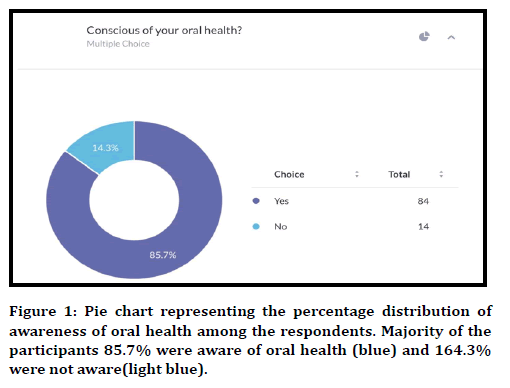
Figure 1. Pie chart representing the percentage distribution of awareness of oral health among the respondents. Majority of the participants 85.7% were aware of oral health (blue) and 164.3% were not aware(light blue).
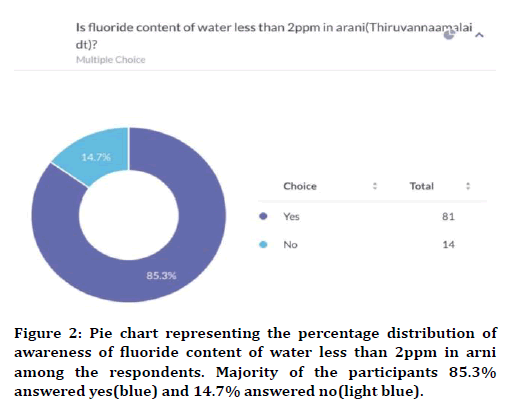
Figure 2. Pie chart representing the percentage distribution of awareness of fluoride content of water less than 2ppm in arni among the respondents. Majority of the participants 85.3% answered yes(blue) and 14.7% answered no(light blue).
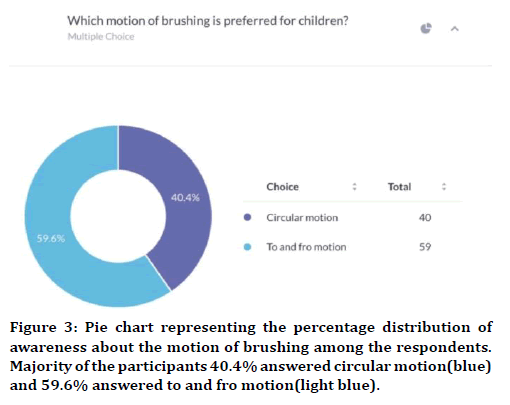
Figure 3. Pie chart representing the percentage distribution of awareness about the motion of brushing among the respondents. Majority of the participants 40.4% answered circular motion(blue) and 59.6% answered to and fro motion(light blue).
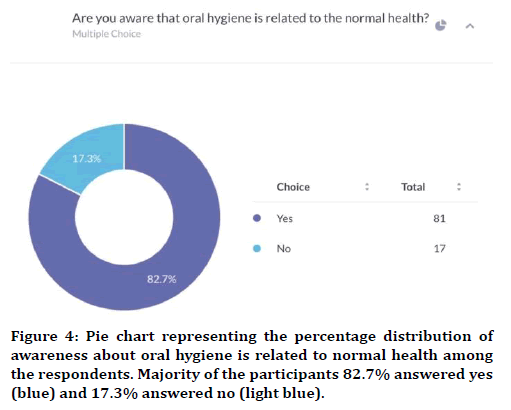
Figure 4. Pie chart representing the percentage distribution of awareness about oral hygiene is related to normal health among the respondents. Majority of the participants 82.7% answered yes (blue) and 17.3% answered no (light blue).
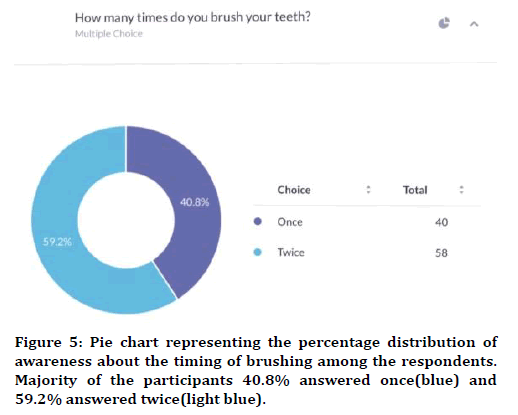
Figure 5. Pie chart representing the percentage distribution of awareness about the timing of brushing among the respondents. Majority of the participants 40.8% answered once(blue) and 59.2% answered twice(light blue).
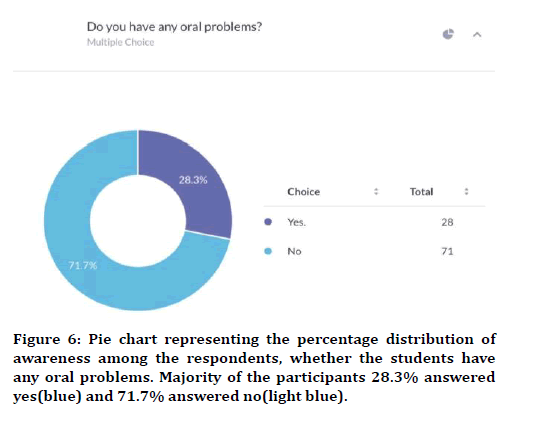
Figure 6. Pie chart representing the percentage distribution of awareness among the respondents, whether the students have any oral problems. Majority of the participants 28.3% answered yes(blue) and 71.7% answered no(light blue).
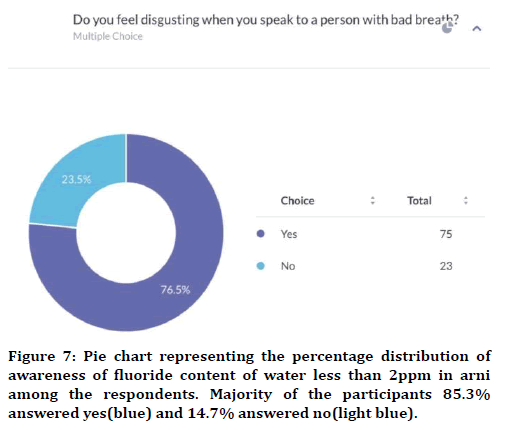
Figure 7. Pie chart representing the percentage distribution of awareness of fluoride content of water less than 2ppm in arni among the respondents. Majority of the participants 85.3% answered yes(blue) and 14.7% answered no(light blue).
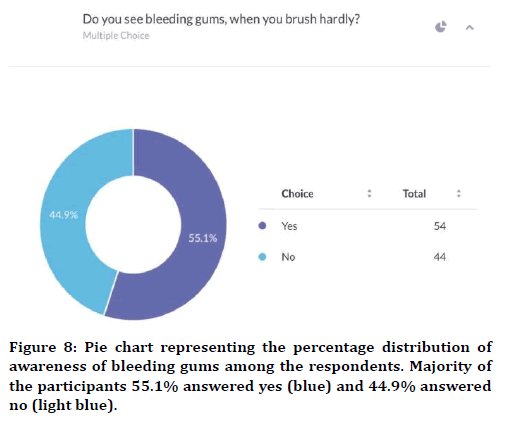
Figure 8. Pie chart representing the percentage distribution of awareness of bleeding gums among the respondents. Majority of the participants 55.1% answered yes (blue) and 44.9% answered no (light blue).
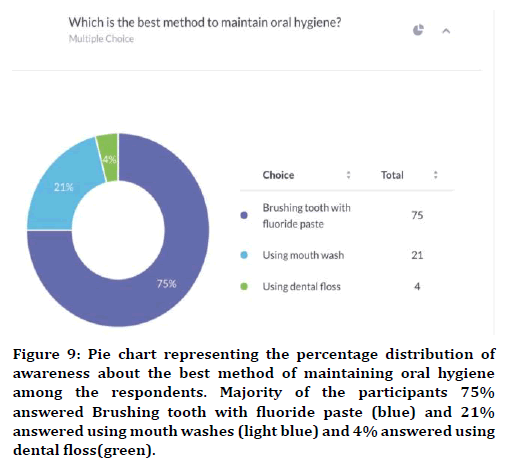
Figure 9. Pie chart representing the percentage distribution of awareness about the best method of maintaining oral hygiene among the respondents. Majority of the participants 75% answered Brushing tooth with fluoride paste (blue) and 21% answered using mouth washes (light blue) and 4% answered using dental floss(green).
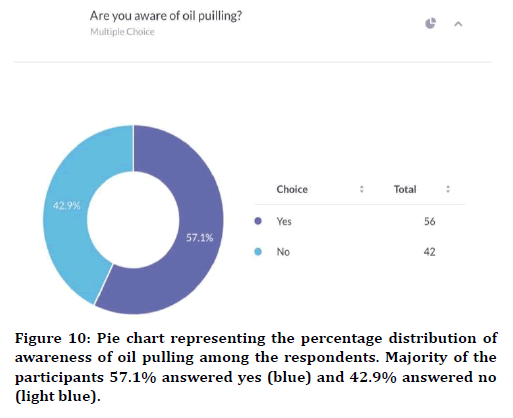
Figure 10. Pie chart representing the percentage distribution of awareness of oil pulling among the respondents. Majority of the participants 57.1% answered yes (blue) and 42.9% answered no (light blue).
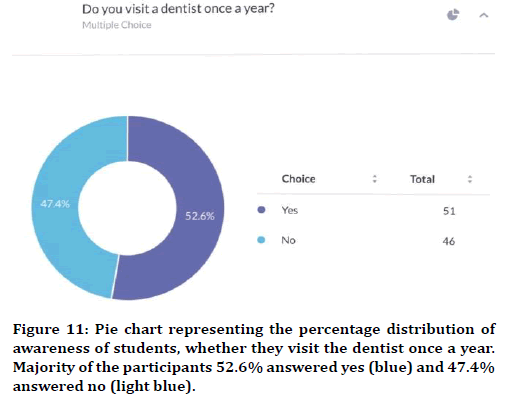
Figure 11. Pie chart representing the percentage distribution of awareness of students, whether they visit the dentist once a year. Majority of the participants 52.6% answered yes (blue) and 47.4% answered no (light blue).
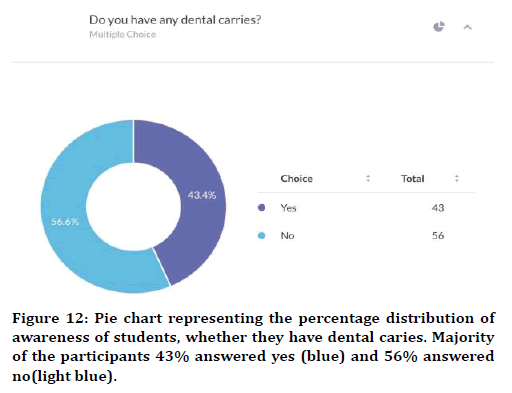
Figure 12. Pie chart representing the percentage distribution of awareness of students, whether they have dental caries. Majority of the participants 43% answered yes (blue) and 56% answered no(light blue).
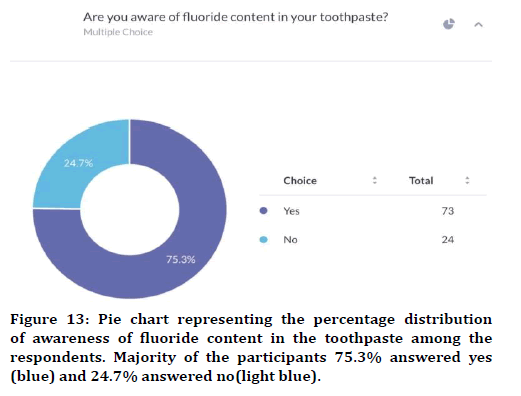
Figure 13. Pie chart representing the percentage distribution of awareness of fluoride content in the toothpaste among the respondents. Majority of the participants 75.3% answered yes (blue) and 24.7% answered no(light blue).
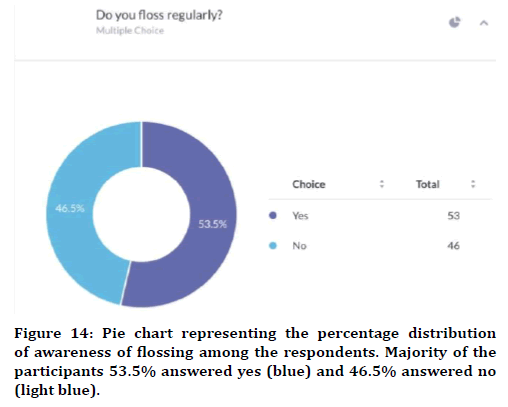
Figure 14. Pie chart representing the percentage distribution of awareness of flossing among the respondents. Majority of the participants 53.5% answered yes (blue) and 46.5% answered no (light blue).
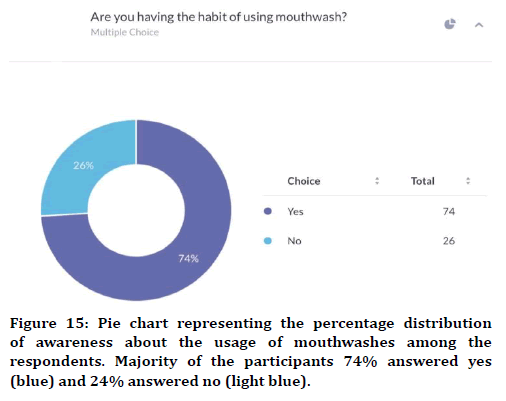
Figure 15. Pie chart representing the percentage distribution of awareness about the usage of mouthwashes among the respondents. Majority of the participants 74% answered yes (blue) and 24% answered no (light blue).
In the study done by Bhat et al, self-reported that 40% of the respondents experienced bleeding gums and 77% of the respondents were aware of bread breath, which supports the study [22]. The study done by Bhaskar et al. mentioned that 2.6% of the respondents used floss, 4.6% students used mouthwashes, 50% of the students changed toothbrushes for every month and supported the present study [23]. Health behavior in general and oral health in particular due to oral health education is complex phenomena, 96% uses fluoride toothpaste and 81% are aware of gum diseases have been discussed in the previous article [24]. The study done by Humagain et al 80% were aware of preventive measures, 66% of the study population was aware about gingival bleeding and 64% reported brushing regularly were supported the present study [25].
Oral awareness of health appeared to be limited, and it was correlated with very little context influences. In the last 12 months, more than half of the students have seen a dentist but about one third of the students was cleaning twice a day or more regularly [26]. A study done by Ashwath et al. 60% of dental students is aware of self-protection of oral health and moderately aware about the consequences about oral health [27]. The study done by Burman et al. concluded that knowledge about the oral hygiene and oral health among the students are unsatisfactory and also need to create awareness about the diseases associated with the oral health, which is contradictory to the present study [2].
Although the study was conducted by following the protocols there are certain limitations in this study like less sample size, this is an online survey which may lead to respondent’s bias, error in sampling and selection of respondents, survey fatigue.
Conclusion
The overall knowledge of oral hygiene among school students was moderate, and there was moderate awareness of the preventive aids. Additional information on flossing, cleaning methods and the protective aids required for dental caries must be imparted. We suggest that findings from our study should be taken into account in oral hygiene programs. Our study gives positive hope that younger generations are well educated about oral health.
Acknowledgment
This research was done under the supervision of the department of research of Saveetha Dental College and Hospitals. We sincerely show gratitude to the corresponding guides who provided insight and expertise that greatly assisted the research.
Conflict of Interest
The author has none to declare.
References
- Gualie YT, Tayachew AT. Assessment of knowledge, attitude, and practice toward oral hygiene among governmental secondary school students in Debre Tabor Town, Amhara Region, North Central Ethiopia 2018: Institutional-based cross-sectional survey. Int J Oral Health Sci 2018; 8:92.
- Burman J, Dasgupta A, Banerjee R, et al. A study on oral hygiene among students of a secondary school in Harinavi, South 24 Parganas, West Bengal. Medical J Dr. DY Patil Vidyapeeth 2019; 12:34.
- Priya M, Devdas K, Amarlal D, et al. Oral health attitudes, knowledge and practice among school children in Chennai, India. J Educ Ethics Dent 2013; 3:26.
- Mhaske S, Yuwanati MB, Keswani H, Jain L. Evaluation of oral health awareness among public school children–A school-based study from Bhopal. Archives of Medicine and Health Sciences. 2018 Jul 1;6(2):214.
- Schmidt JC, Zaugg C, Weiger R, et al. Brushing without brushing?—A review of the efficacy of powered toothbrushes in noncontact biofilm removal. Clin Oral Investigations 2013; 17:687-709.
- Claydon NC. Current concepts in toothbrushing and interdental cleaning. Periodontol 2008; 48:10–22.
- Lee DW, Moon IS. The plaque-removing efficacy of a single-tufted brush on the lingual and buccal surfaces of the molars. J Periodont Implant Sci 2011; 41:131-134.
- Mahasneh SA, Mahasneh AM. Probiotics: A promising role in dental health. Dent J 2017; 5:26.
- Dakhili S, Alsuwaidi N, Saeed S, et al. Oral hygiene: Association between knowledge and practice among school going children in Ajman, United Arab Emirates. Am J Res Communication 2014; 2:39-48.
- Al Subait AA, Alousaimi M, Geeverghese A, et al. Oral health knowledge, attitude and behavior among students of age 10–18 years old attending Jenadriyah festival Riyadh; A cross-sectional study. Saudi J Dent Res 2016; 7:45-50.
- Begum R, Ariga P, Jain AR. Evaluation of corrosive behavior of four nickel–chromium alloys in artificial saliva by cyclic polarization test: An in vitro study. World J Dent 2017; 8:477-482.
- Ganapathy DM, Kannan A, Venugopalan S. Effect of coated surfaces influencing screw loosening in implants: A systematic review and meta-analysis. World J Dent 2017; 8:496–502.
- Jain AR. Clinical and functional outcomes of implant prostheses in fibula free flaps. World J Dent 2017; 8:171–176.
- Jain AR. Prevalence of partial edentulousness and treatment needs in rural population of South India. World J Dent 2017; 8:213–217.
- Ranganathan H, Ganapathy DM, Jain AR. Cervical and incisal marginal discrepancy in ceramic laminate veneering materials: A SEM analysis. Contemporary Clin Dent 2017; 8:272–278.
- Jain AR, Nallaswamy D, Ariga P, et al. Determination of correlation of width of maxillary anterior teeth using extraoral and intraoral factors in Indian population: A systematic review. World J Dent 2018; 9:68-75.
- Gupta P, Ariga P, Deogade SC. Effect of monopoly-coating agent on the surface roughness of a tissue conditioner subjected to cleansing and disinfection: A contact profilometric study. Contemporary Clin Dent 2018; 9:S122–S126.
- Anbu RT, Suresh V, Gounder R, et al. Comparison of the efficacy of three different bone regeneration materials: An animal study. Eur J Dent 2019; 13:22.
- Ashok V, Ganapathy D. A geometrical method to classify face forms. J Oral Biol Craniofac Res 2019; 9:232–235.
- Duraisamy R, Krishnan CS, Ramasubramanian H, et al. Compatibility of nonoriginal abutments with implants: evaluation of microgap at the implant–abutment interface, with original and nonoriginal abutments. Implant Dent 2019; 28:289-295.
- Varghese SS, Ramesh A, Veeraiyan DN. Blended module‐based teaching in biostatistics and research methodology: A retrospective study with postgraduate dental students. J Dent Educ 2019; 83:445-50.
- Almas K, Al-Hawish A, Al-Khamis W. Oral hygiene practices, smoking habit, and self-perceived oral malodor among dental students. J Contemp Dent Pract 2003; 4:77-90.
- Gopikrishna V, Bhaskar NN, Kulkarni SB, et al. Knowledge, attitude, and practices of oral hygiene among college students in Bengaluru city. J Indian Assoc Public Health Dent 2016; 14:75.
- Andhare MG, Dhonge RP, Dhuldhwaj RM, et al. A comparative evaluation of awareness regarding periodontal health and oral hygiene practices among dental and medical undergraduate students in Beed District of Maharashtra. Indian J Dent Sci 2017; 9:215.
- http://www.webmedcentral.co.uk/wmcpdf/Article_WMC001805.pdf
- Al-Ansari J, Honkala E, Honkala S. Oral health knowledge and behavior among male health sciences college students in Kuwait. BMC Oral Health 2003; 3:2.
- Ashwath B, Vijayalakshmi R, Malini S. Self-perceived halitosis and oral hygiene habits among undergraduate dental students. J Indian Society Periodontol 2014; 18:357-360.
Author Info
B Madhumitha, Dhanaraj Ganapathy* and L Keerthi Sasanka
Department of Prosthodontics, Saveetha Dental College and Hospitals, Saveetha Institute of Medical and Technical Sciences, Saveetha University Tamilnadu, Chennai, IndiaCitation: B Madhumitha, Dhanaraj Ganapathy, L Keerthi Sasanka, Awareness on oral hygiene among high school students in Arni, J Res Med Dent Sci, 2021, 9 (1): 297-302.
Received: 23-Sep-2020 Accepted: 08-Jan-2021
